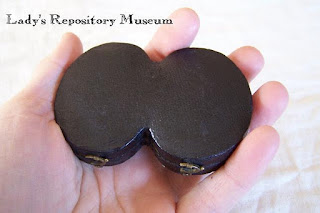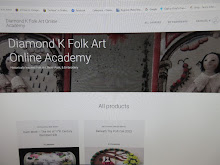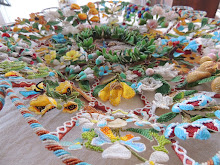 I wish there would have been photography in the 18th century~ don't you? If there was, just think of the wealth of knowledge that could be gleaned from looking beyond the focus of the image....like everyday things sitting beyond on a table or in a windowsill. It is sometimes hard to remember that early paintings were almost as accurate as a photograph, but they were.
I wish there would have been photography in the 18th century~ don't you? If there was, just think of the wealth of knowledge that could be gleaned from looking beyond the focus of the image....like everyday things sitting beyond on a table or in a windowsill. It is sometimes hard to remember that early paintings were almost as accurate as a photograph, but they were.If we see a ladye, such as Maria Christina, above~ painted by Johann Zoffany in 1776, wearing these jewels, we can most definitely count on the fact that they did exist and she was wearing them...weather or not she actually owned them or not is another story, but we need not get into that here and now. Wouldn't it be grand, to see what , say, her bracelets could have actually looked like...in the flesh?
Look at this beautiful shagreen case. It in itself is worthy of a post of its own~ Shagreen is a type of treatment of leather made from a type of shark skin or ray skin, that is covered with weensie tiny bumps~ little calcifications~ and it is colored from the underneath, usually a very dark green
 Just a peek of what is within... Imagine yourself now, a Ladye of much means, with a beaux of even more, wanting to show his romantic intentions with a trifle of affection....
Just a peek of what is within... Imagine yourself now, a Ladye of much means, with a beaux of even more, wanting to show his romantic intentions with a trifle of affection....
 I don't know about you, but I would be sucking in a big gasp about now.....
I don't know about you, but I would be sucking in a big gasp about now.....
 For within the beautifully fitted, silk lined double case, is a gorgeous, all original set of paste buckles. But yet, these are no ordinary buckles. Not...no....not intended for shoes, these were for the wrists. They test sterling, with 18k gold tooled middle banding, and each is set with 72 huge, luscious heavy paste stones. Even the elite wore past jewels in the 18th c~ there were more paste jewelers and more paste jewels sold in London than Diamonds and precious gems. If the paste was of high quality, such as these, with high lead content, they really did sparkle just as much as diamonds.
For within the beautifully fitted, silk lined double case, is a gorgeous, all original set of paste buckles. But yet, these are no ordinary buckles. Not...no....not intended for shoes, these were for the wrists. They test sterling, with 18k gold tooled middle banding, and each is set with 72 huge, luscious heavy paste stones. Even the elite wore past jewels in the 18th c~ there were more paste jewelers and more paste jewels sold in London than Diamonds and precious gems. If the paste was of high quality, such as these, with high lead content, they really did sparkle just as much as diamonds.
 On the back, looking on the chape, you can see "1380" stamped into the silver~ this is the patent number
On the back, looking on the chape, you can see "1380" stamped into the silver~ this is the patent number
 On the reverse of the chape is stamped "Stedman Patent". Most exciting! Both buckles are marked, and made by John Stedman in London, 1783. We know that John Stedman took out Patent number 1350 on 13 Jan 1783 for a certain type shoe buckle....and on 19 Dec 1783 for patent number 1410....so this pair most definitely dates to 1783.
On the reverse of the chape is stamped "Stedman Patent". Most exciting! Both buckles are marked, and made by John Stedman in London, 1783. We know that John Stedman took out Patent number 1350 on 13 Jan 1783 for a certain type shoe buckle....and on 19 Dec 1783 for patent number 1410....so this pair most definitely dates to 1783.
 John Stedman was a jeweler and patent buckle maker who worked and lived in London~ he has documented residence at No 2 Prince Street, Leicester Fields, Middle Temple Lane and 36 New Bond Street among others. What is so very interesting, and most likely the patent feature of this set, is the placement of the prongs~ see above here~ where my fingers are, the prongs are actually attached to the back side of the buckle itself, and not the center of the chape
John Stedman was a jeweler and patent buckle maker who worked and lived in London~ he has documented residence at No 2 Prince Street, Leicester Fields, Middle Temple Lane and 36 New Bond Street among others. What is so very interesting, and most likely the patent feature of this set, is the placement of the prongs~ see above here~ where my fingers are, the prongs are actually attached to the back side of the buckle itself, and not the center of the chape
 They are absolutely gorgeous in person, the amount of paste stones is mesmerizing~ imagine how these looked in candlelight~ nothing less than spectacular to be sure.
They are absolutely gorgeous in person, the amount of paste stones is mesmerizing~ imagine how these looked in candlelight~ nothing less than spectacular to be sure.
 Buckles such as these would have been worn on a ribbon around the wrists. The ribbon could easily be interchanged to suit M'Lady's wardrobe or even time of day. Simply put, a length of ribbon would have a slit at one end, and a set of 2 little holes at the other for the prongs to catch in. The chape is slipped thru the slit in the ribbon, and turned to make the catch as you see above~ this is actually very secure
Buckles such as these would have been worn on a ribbon around the wrists. The ribbon could easily be interchanged to suit M'Lady's wardrobe or even time of day. Simply put, a length of ribbon would have a slit at one end, and a set of 2 little holes at the other for the prongs to catch in. The chape is slipped thru the slit in the ribbon, and turned to make the catch as you see above~ this is actually very secure
 The ribbon is then brought around the wrist, thru the hole in the chape, and the prongs on the back side of the buckle catch the ribbon, as above
The ribbon is then brought around the wrist, thru the hole in the chape, and the prongs on the back side of the buckle catch the ribbon, as above
 Just a peek of what is within... Imagine yourself now, a Ladye of much means, with a beaux of even more, wanting to show his romantic intentions with a trifle of affection....
Just a peek of what is within... Imagine yourself now, a Ladye of much means, with a beaux of even more, wanting to show his romantic intentions with a trifle of affection.... I don't know about you, but I would be sucking in a big gasp about now.....
I don't know about you, but I would be sucking in a big gasp about now..... For within the beautifully fitted, silk lined double case, is a gorgeous, all original set of paste buckles. But yet, these are no ordinary buckles. Not...no....not intended for shoes, these were for the wrists. They test sterling, with 18k gold tooled middle banding, and each is set with 72 huge, luscious heavy paste stones. Even the elite wore past jewels in the 18th c~ there were more paste jewelers and more paste jewels sold in London than Diamonds and precious gems. If the paste was of high quality, such as these, with high lead content, they really did sparkle just as much as diamonds.
For within the beautifully fitted, silk lined double case, is a gorgeous, all original set of paste buckles. But yet, these are no ordinary buckles. Not...no....not intended for shoes, these were for the wrists. They test sterling, with 18k gold tooled middle banding, and each is set with 72 huge, luscious heavy paste stones. Even the elite wore past jewels in the 18th c~ there were more paste jewelers and more paste jewels sold in London than Diamonds and precious gems. If the paste was of high quality, such as these, with high lead content, they really did sparkle just as much as diamonds. On the back, looking on the chape, you can see "1380" stamped into the silver~ this is the patent number
On the back, looking on the chape, you can see "1380" stamped into the silver~ this is the patent number On the reverse of the chape is stamped "Stedman Patent". Most exciting! Both buckles are marked, and made by John Stedman in London, 1783. We know that John Stedman took out Patent number 1350 on 13 Jan 1783 for a certain type shoe buckle....and on 19 Dec 1783 for patent number 1410....so this pair most definitely dates to 1783.
On the reverse of the chape is stamped "Stedman Patent". Most exciting! Both buckles are marked, and made by John Stedman in London, 1783. We know that John Stedman took out Patent number 1350 on 13 Jan 1783 for a certain type shoe buckle....and on 19 Dec 1783 for patent number 1410....so this pair most definitely dates to 1783. John Stedman was a jeweler and patent buckle maker who worked and lived in London~ he has documented residence at No 2 Prince Street, Leicester Fields, Middle Temple Lane and 36 New Bond Street among others. What is so very interesting, and most likely the patent feature of this set, is the placement of the prongs~ see above here~ where my fingers are, the prongs are actually attached to the back side of the buckle itself, and not the center of the chape
John Stedman was a jeweler and patent buckle maker who worked and lived in London~ he has documented residence at No 2 Prince Street, Leicester Fields, Middle Temple Lane and 36 New Bond Street among others. What is so very interesting, and most likely the patent feature of this set, is the placement of the prongs~ see above here~ where my fingers are, the prongs are actually attached to the back side of the buckle itself, and not the center of the chape They are absolutely gorgeous in person, the amount of paste stones is mesmerizing~ imagine how these looked in candlelight~ nothing less than spectacular to be sure.
They are absolutely gorgeous in person, the amount of paste stones is mesmerizing~ imagine how these looked in candlelight~ nothing less than spectacular to be sure. Buckles such as these would have been worn on a ribbon around the wrists. The ribbon could easily be interchanged to suit M'Lady's wardrobe or even time of day. Simply put, a length of ribbon would have a slit at one end, and a set of 2 little holes at the other for the prongs to catch in. The chape is slipped thru the slit in the ribbon, and turned to make the catch as you see above~ this is actually very secure
Buckles such as these would have been worn on a ribbon around the wrists. The ribbon could easily be interchanged to suit M'Lady's wardrobe or even time of day. Simply put, a length of ribbon would have a slit at one end, and a set of 2 little holes at the other for the prongs to catch in. The chape is slipped thru the slit in the ribbon, and turned to make the catch as you see above~ this is actually very secure The ribbon is then brought around the wrist, thru the hole in the chape, and the prongs on the back side of the buckle catch the ribbon, as above
The ribbon is then brought around the wrist, thru the hole in the chape, and the prongs on the back side of the buckle catch the ribbon, as above**I must thank Mr Clive Taylor for his most generous help in assisting me with information on John Stedman**
I wish you all could see these in person~ the sparkle is just devine~ I couldn't help but make a little video for you~ I hope you enjoy~







































